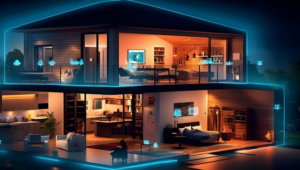The integration of technology into architectural design has ushered in a new era of smart homes, transforming the way we interact with our living spaces, enhancing convenience, improving energy efficiency, and optimizing security. As technology continues to advance, the future of smart homes is poised to further revolutionize the relationship between architecture and technology, offering a seamless and intuitive living experience. Let’s explore how architects are integrating technology into the design of smart homes, and how these innovations are shaping the future of residential living.

IoT Integration
The Internet of Things (IoT) is at the forefront of smart home technology. Architectural designs are increasingly incorporating IoT devices such as smart thermostats, connected appliances, and automated lighting systems that can be controlled remotely through smartphones or voice commands. These innovations enhance convenience, energy efficiency, and overall management of the home environment.
Energy Efficiency and Sustainability
Smart homes leverage technology to optimize energy usage through the integration of smart HVAC systems, energy monitoring devices, and efficient lighting controls. Architects are incorporating renewable energy solutions, such as solar panels and energy storage systems, into the design of smart homes to reduce environmental impact and promote sustainability.
Home Automation and Control
The future of smart homes will offer seamless automation and control of various systems within the home. Architects are designing integrated systems that allow residents to monitor and manage lighting, security, entertainment, and climate control, creating a personalized and efficient living environment.
Assistive Technologies
Smart homes are incorporating assistive technologies to accommodate residents with diverse needs, including individuals with disabilities or elderly occupants. Architecture is evolving to incorporate universal design principles and accessible technology features, such as voice-activated controls, remote monitoring, and personalized health and wellness systems.
Data Analytics and Home Intelligence
The future of smart homes involves the integration of data analytics and artificial intelligence to optimize resource usage, predict maintenance needs, and tailor the home environment to the preferences and habits of residents. This advanced level of customization and intelligence will create homes that adapt to the changing needs of occupants.
Seamless Connectivity
Architects are designing smart homes with robust digital infrastructure, ensuring seamless connectivity for smart devices, entertainment systems, and communication networks. High-speed internet, Wi-Fi mesh networks, and smart home hubs are fundamental components of the future smart home architecture.
Security and Privacy
Smart home architecture integrates advanced security systems, including smart locks, surveillance cameras, and biometric authentication, to ensure the safety and privacy of residents. Design innovations prioritize secure and encrypted communication protocols to protect smart home devices from cyber threats.
Conclusion
In conclusion, the future of smart homes is centred on the seamless integration of advanced technologies into architectural design, creating living spaces that are intuitive, efficient, and adaptable to the diverse needs of residents. Architects play a pivotal role in conceptualizing and implementing these innovations, shaping a future where technology and architecture converge to create transformative living environments. Smart homes of the future will not only offer enhanced comfort and convenience but will also be environmentally sustainable, accessible, and secure, redefining the way we experience and interact with our homes.